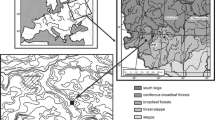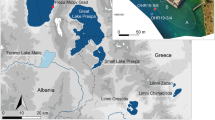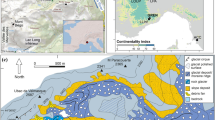Abstract
The history and continuity of lowland woodlands in Central Europe is closely connected with human activities. We studied a small wetland situated directly in a low-elevation oak-dominated woodland to evaluate the history and impact of humans on an oak woodland in south-eastern Slovakia. We used different proxies to obtain evidence of woodland history spanning at least 8,500 years. Pollen, diatom and physical analysis, including micromorphology, were used to study infill sediments and to determine the processes causing the influx of material into the wetland basin from its surroundings. The oak-dominated woodland community occurred throughout the Holocene, but its detailed history is impossible to trace because of reverse chronology caused by mixing of deposits. The stability of the oak woodland was determined by anthropogenic disturbances such as grazing. These disturbances are indicated by pollen taxa, signals of soil erosion in the deposits, and local development of the wetland that acted as drinking and hemp retting basin. The recent decline of human pressure has led to gradual changes in the species composition of the wetland itself (shrub encroachment) and of understory of the surrounding oak woodlands.






Similar content being viewed by others
References
Behre K-E (1986) Anthropogenic indicators in pollen diagrams. A. A. Balkema, Rotterdam
Béreš J, Gačková L, Klíma M, Chovanec J (2004) Archeologické dedičstvo Zemplína: pravek až včasný stredovek [Archaeological heritage of Zemplén: prehistory and early mediaeval period]. Občianske združenie, Zemplínska spoločnosť, Michalovce
Beug HJ (2004) Leitfaden der pollenbestimmung für Mitteleuropa und angrenzende Gebiete. Verlag Dr. Fridrich Pfeil, München
Billamboz A (2003) Tree rings and wetland occupation in southwest Germany between 2000 and 500 BC: dendroarchaeology beyond dating. Tree-Ring Res 59:37–49
Bronk Ramsey C, Dee M, Lee S, Nakagawa T, Staff RA (2010) Developments in the calibration and modelling of radiocarbon dates. Radiocarbon 52:953–961
Buczkó K, Magyari EK, Braun M, Bálint M (2013) Diatom-inferred lateglacial and Holocene climatic variability in the South Carpathian Mountains (Romania). Quatern Int 271:123–135
Bullock P, Fedoroff N, Jongerius A, Stoops G, Tursina T, Babel U (1985) Handbook for soil thin section description. Waine Research Publications, Wolverhampton
Daniels RE, Eddy A (1985) Handbook of European Sphagna. Abbots Ripton Institute of Terrestrial Ecology, Huntingdon
Dítě D, Hájek M, Svitková I, Košuthová A, Šoltés R, Kliment J (2018) Glacial-relict symptoms in the Western Carpathian flora. Folia Geobot 53:277–300
Faliński JB (1986) Vegetation dynamics in temperate lowland primeval forest. In Faliński JB (ed) Geobotany. Dr W. Junk Publishers, Dordrecht, Netherlands, pp 39–111
Feurdean A (2005) Holocene forest dynamics in northwestern Romania. The Holocene 15:435–446
Fraňo A, Jurko A, Šomšák L (1971) Böden und Wälder der Zemplíner Hügel (Slowakei). Acta Fac Rerum Nat Univ Comenius, Bot 17:1–60
Götmark F (2007) Careful partial harvesting in conservation stands and retention of large oaks favour oak regeneration. Biol Conservation 140:349–358
Hájková P, Jamrichová E, Horsák M, Hájek M (2013) Holocene history of a Cladium mariscus-dominated calcareous fen in Slovakia: vegetation stability and landscape development. Preslia 85:289–315
Haneca K, van Acker J, Beeckman H (2005) Growth trends reveal the forest structure during Roman and medieval times in Western Europe: a comparison between archaeological and actual oak ring series (Quercus robur and Quercus petraea). Ann Forest Sci 62:797–805
Hédl R, Rejšek K (2007) Soil changes after forty years of succession in an abandoned coppice in the Czech Republic. Acta Agron Hung 55:453–474
Hédl R, Kopecký M, Komárek J (2010) Half a century of succession in a temperate oakwood: from species-rich community to mesic forest. Diversity & Distrib 16:267–276
Jakubowska-Gabara J (1996) Decline of Potentillo albae-Quercion Libb. 1933 phytocoenoses in Poland. Vegetatio 124:45–59
Jamrichová E, Szabó P, Hédl R, Kuneš P, Bobek P, Pelánková B (2013) Continuity and change in the vegetation of a Central European oakwood. The Holocene 23:46–56
Jamrichová E, Potůčková A, Horsák M, Hajnalová M, Barta P, Tóth P, Kuneš P (2014) Early occurrence of temperate oak-dominated forest in the northern part of the Little Hungarian Plain, SW Slovakia. The Holocene 24:1810–1824
Jamrichová E, Petr L, Jimenez-Alfaro B, Jankovská V, Dudová L, Pokorný P, Kolaczek P, Zernitskyay V, Cierniková M, Břízová E, Syrovátka V, Hájková P, Hájek M (2017) Pollen-inferred millennial changes in landscape patterns at a major biogeographical interface within Europe. J Biogeogr 44:2386–2397
Jamrichová , Gálová A, Gašpar A, Froldová J, Hájek M, Hajnalová M, Hájková P (2018) Holocene development of two calcareous spring fens at the Carpathian-Pannonian interface controlled by climate and human impact. Folia Geobot 53:243–263
Kaminská Ł, Ďuďa R (1985) K otázce významu obsidiánovej suroviny v paleolite Slovenska (Importance of obsidian sources of Slovakian Palaeolithic). Archeol Rozhl 37:121–129
Kooijman AM,Cammeraat E (2010) Biological control of beech and hornbeam affects species richness via changes in the organic layer, pH and soil moisture characteristics. Funct Ecol 24:469–477
Krippel E (1986) Postglaciálny vývoj vegetácie Slovenska (Postglacial development of vegetation of Slovakia). Vydavatelstvo SAV, Bratislava
Kwiatkowska AJ, Spalyk K, Michalak E, Palińska A, Panufnik D (1997) Influence of the size and density of Carpinus betulus on the spatial distribution and rate of deletion of forest-floor species in thermophilous oak forest. Pl Ecol 129:1–10
Lange-Bertalot H, Bąk M, Witkowski A (2011) Eunotia and some related genera. In Lange-Bertalot H (ed.) Diatoms of Europe 6. Gantner Verlag, pp 1–747
Magyari EK, Chapman JC, Passmore DG, Allen JRM, Huntley JP, Huntley B (2010) Holocene persistence of wooden steppe in Great Hungarian Plain. J Biogeogr 37:915–935
Mapire website (2018) http://www.mapire.eu/en (Accessed 20 May 2019)
Mitchell FJG, Cole E (1998) Reconstruction of long-term successional dynamics of temperate woodland in Białowieża Forest, Poland. J Ecol 86:1042–1059
Moore PD, Webb JA, Collinson ME (1991) Pollen analysis, 2nd eds. Blackwell, Oxford
Nalepka D, Walanus A (2003) Data processing in pollen analysis. Acta Palaeobot 43:125–134
Neuhäusl R, Neuhäuslová Z (1967) Die Waldgesellschaften der Zemplíner Hügel (SO-Slowakei). Gradina Bot 589:247–262
Peciar V (1967) Moose (Bryophyta) des südlichen Teils der Ostslowakischem Tiefebene. Acta Fac Rerum Nat Univ Comen, Bot 14:25–81
Petr L, Žáčková P, Grygar TM, Píšková, A, Křížek M, Treml V (2013) Šúr – former Lateglacial and Holocene lake on westernmost margin of Carpathians. Preslia 85:239–263
Rackham O (2003) Ancient woodland: its history, vegetation and use in England. 2nd edn. Castlepoint Press, Colvend
Ralska-Jasiewiczowa M, Nalepka D, Goslar T (2003) Some problems of forest transformation at the transition to the oligocratic/Homo sapiens phase of the Holocene interglacial in northern lowlands of central Europe. Veget Hist & Archaeobot 12:233–247
Reimer PJ, Bard E, Bayliss A, Beck J. et al. (2013) IntCal13 and Marine13 Radiocarbon Age Calibration Curves 0–50,000 Years cal BP. Radiocarbon 55:1869–1887
Roleček J (2005) Vegetation types of dry-mesic oak forests in Slovakia. Preslia 77:241–261
Round FE, Basson PW (1997) A new monoraphid diatom genus (Pogoneis) from Bahrain and the transfer of previously described species A. hungarica and A. taeniata to new genera. Diatom Res 12:71–81
Simon T (1977) Vegetationsunteruchungen im Zemplíner Gebirge. Akadémiai Kiadó, Budapest
Šoltés R (2000) Prehlaď rodu Sphagnum L. (Musscopsida) na Slovensku [Review of the genus Sphagnum in Slovakia]. In Stanová V (ed) Rašeliniská Slovenska [peatbogs of Slovakia]. DAPHNE – Inštitůt aplikovanej ekologie, Bratislava, pp 33–38
Svenning J-C (2002) A review of natural vegetation openness in north-western Europe. Biol Conservation 104:133–148
Szabó P (2010) Driving forces of stability and change in woodland structure: a case-study from the Czech lowlands. Forest Ecol Managem 259:650–656
Tinner W, Conedera M, Ammann B, Lotter AF (2005) Fire ecology north and south of the Alps since the last Ice Age. The Holocene 15:1214–1226
van der Werff A (1955) A new method for cleaning and concentrating diatoms and other organisms. Verh Int Vereinigungfürtheor Angew Limnol 12:276–277
Vera FWM (2000) Grazing ecology and forest history. CABI Publishing, Wallingford & New York
Willis KJ, Sümegi P, Braun M, Tóth A (1997) Does soil change cause vegetation change or vice versa? A temporal perspective from Hungary. Ecology 78:740–750
Willis KJ, Sümegi P, Braun M, Bennett KD, Tóth A (1998) Prehistoric land degradation in Hungary: who, how and why? Antiquity 72:101–113
Acknowledgements
Our research was supported by the grant projects GA17-05696S of the Czech Science Foundation (GAČR), VEGA 1/0477/11, APPV-14-0550, and the long-term research development project of the Botanical Institute AVSR RVO 67985939. Many thanks to Ivan Jarolímek and Milan Valachovič for kindly providing vegetation data and Leona Chadimová for measuring magnetic susceptibility. We also thank Petra Hájková and Michal Hájek for their comments, Lydie Dudová, Slavo Rezník and Standa Němejc for help with field work and Ladislav Olexa and Tomáš Nováček for their kind support.
Author information
Authors and Affiliations
Corresponding author
Additional information
Publisher’s Note
Springer Nature remains neutral with regard to jurisdictional claims in published maps and institutional affiliations.
Rights and permissions
About this article
Cite this article
Petr, L., Petřík, J., Chattová, B. et al. The history of a Pannonian oak woodland – palaeoecological evidence from south-eastern Slovakia. Folia Geobot 55, 29–40 (2020). https://doi.org/10.1007/s12224-019-09360-5
Received:
Revised:
Accepted:
Published:
Issue Date:
DOI: https://doi.org/10.1007/s12224-019-09360-5




